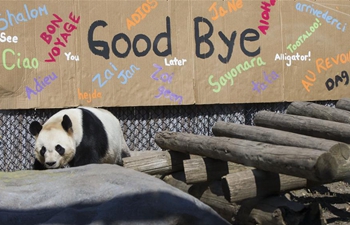by Raul Menchaca
MATANZAS, Cuba, March 18 (Xinhua) -- Cuban researcher Marlene Prieto is passionate about two things: silkworm breeding and mulberry cultivation and she has been leading a project combining these two since 2005.
Prieto, an agronomist, has worked since she was 18 in the "Indio Hatuey" Experimental Station of Pastures and Forages, an agricultural research center in the municipality of Jaguey Grande, 147 km southeast of Havana.
The 52-year-old expert is enthusiastic about the progress of this silkworm breeding program, one of the projects promoted by late Cuban President Fidel Castro.
It began in the early 1990s, when mulberry trees were first planted in the institution to be used as animal feed.
A decade later, the sericulture project began with the arrival of the first silkworm eggs. When they hatched, the worms were fed with mulberry, a plant with 19 varieties at the station.
The silkworms grow fast in a few weeks from three millimeters to six or seven centimeters.
In the breeding shed, only five people take care of the worms which eat up to 500 kg of mulberry during the four weeks that it takes them to grow and turn into cocoons that produce silk yarn.
"The first result we had with this technology was to achieve a production of quality cocoons to have the handicraft thread as the final product," Prieto told Xinhua.
She explained that sericulture demands a combination of human care and the work of the worm that can produce a very fine thread that comes from the worm's salivary glands.
This activity does not require large investments, but does involve dedication to maintain the right temperature, humidity, clean the breeding facilities, and take care of mulberry plantations, which provide food during the life cycle.
An Italian non-governmental organization and the European Union jointly set up a training center in the station in 2013 and in three years, about 300 people had been trained to make silk products there.
In 2016, the project won an award from the Cuban Ministry of Science, Technology and Environment. However, the project was halted in the same year after the European side quit financing it.
"It was a very nice experience to cooperate with these people. I think it was the first time that an agricultural investigation center could link the population with its own work," Prieto said.
Prieto and her colleagues are looking for ways to recycle the waste generated by the production, such as the pupa oil from the worms and the water used to process the cocoons.
Both forms of residue are rich in proteins such as sericin, which is used in the pharmaceutical and cosmetology industries.
They are also seeking new sources of financing, or commercial alliances to continue research on the worm and the silk production, with China being a great potential partner.
"China would be an excellent partner, since they started raising the silkworm thousands of years ago," said Prieto.













